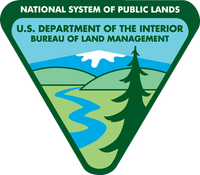
About FlashAlert on Twitter:
FlashAlert utilizes the free service Twitter to distribute emergency text messages. While you are welcome to register your cell phone text message address directly into the FlashAlert system, we recommend that you simply "follow" the FlashAlert account for Bureau of Land Management Ore. & Wash. by clicking on the link below and logging in to (or creating) your free Twitter account. Twitter sends messages out exceptionally fast thanks to arrangements they have made with the cell phone companies.
Strategically placed fuel breaks in Idaho, Oregon, Washington, California, Nevada and Utah will help firefighters control wildfires
BOISE, Idaho – Today, the Bureau of Land Management (BLM) released the Final Programmatic Environmental Impact Statement (PEIS) for Fuel Breaks in the Great Basin. This Final PEIS provides for the construction and maintenance of a system of up to 11,000 miles of strategically placed fuel breaks to control wildfires within a 223 million acre area that includes portions of Idaho, Oregon, Washington, California, Nevada and Utah.
The Preferred Alternative outlined in the PEIS analyzes a full suite of manual, chemical and mechanical treatments, including prescribed fire, seeding, and targeted grazing to construct and maintain a system of fuel breaks. These treatments would be implemented along roads and rights-of-way on BLM-administered lands to minimize new disturbance and wildlife habitat fragmentation and to maximize accessibility for wildland firefighters.
“Recovering from the devastating effects of wildlfires can take decades in the rugged, high-desert climate of the Great Basin. These tools will help firefighters contain fires when they break out,” said Acting Assistant Secretary of the Interior for Land and Minerals Management Casey Hammond. “That’s why creating fuel breaks is incredibly important to the entire basin, the people who live in these communities, and our wildland firefighters.”
“Wildfires pose an enormous threat to rangelands in the Great Basin – rangelands that people depend on for both recreational opportunities and their livelihoods, and that wildlife rely on for habitat,” said BLM Deputy Director for Policy and Programs William Perry Pendley. “Fuel breaks are one of the most important tools we have to give wildland firefighters a chance to safely and effectively contain rapidly moving wildfires and potentially reduce wildfire size.”
Wildfires in sagebrush communities in the Great Basin states are becoming more frequent and larger, fueled by large, unbroken swaths of grasses, brush and other vegetation. Over 13.5 million acres of historically sagebrush communities on BLM land burned within the project area between 2009 and 2018. Wildfires that consume sagebrush provide the opportunity for invasive annual grasses to increase, making future large and severe wildfires more likely.
The concept behind fuel breaks is to break up or fragment continuous fuels by reducing vegetation in key locations. When a wildfire burns into a fuel break, the flame lengths decrease and its progress slows, making it safer and easier for firefighters to control.
“All of wildland firefighting is centered around constructing fuel breaks,” said BLM Idaho State Director John Ruhs. “Every time we construct a fireline around a wildfire using hand tools on the ground, every time we drop fire retardant, and every time we herd a wildfire into a previously burned area, we are using fuel breaks. Through this PEIS we’ll be able to proactively construct fuel breaks where we know we will need them, instead of creating them reactively in responding to wildfires.”
The BLM has extensively documented that fuel breaks, and other types of fuel treatments, are effective. Since 2002, the agency has assessed more than 1,200 fuel breaks and other types of fuel treatments that intersected with wildfires and has found that 78% of them were effective in helping to control wildfires and that 84% of them were effective in helping change fire behavior.
An electronic copy of the Final PEIS and associated documents is available for public review for 30 days on the BLM Land Use Planning and NEPA register at https://go.usa.gov/xnQcG The BLM will issue a Record of Decision after the end of the public review period.
-BLM-
The BLM manages more than 245 million acres of public land located primarily in 12 Western states, including Alaska. The BLM also administers 700 million acres of sub-surface mineral estate throughout the nation. In fiscal year 2018, the diverse activities authorized on BLM-managed lands generated $105 billion in economic output across the country. This economic activity supported 471,000 jobs and contributed substantial revenue to the U.S. Treasury and state governments, mostly through royalties on minerals.